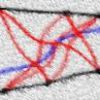 21
211) Use newtons law of cooling;
d(theta) / dt = -bA (theta - theta (surr))
so u see ,time is inversely proportional to AREA
so u get 25 sec as the answer ;)
 21
213) I think i m right
U(energy per unit time) = stefan constn * A * T(sun)4 where A = area of sun
Now U / 4 pi R^2 = (Radiation we get per unit time per unit area), because radious of earth <<<<<that of sun
( where R = distance b2n earth and sun )
from here u can calculate T, which is the temp of sun
 21
212) what is the a value for that block??
 1
1shubhodip
1]see
m.s.d(theta) / dt = -bA (theta - theta (surr))
so ans 200
 21
21yes i was careless about the mass, thanks for pointing out the mistake ;(:::::)